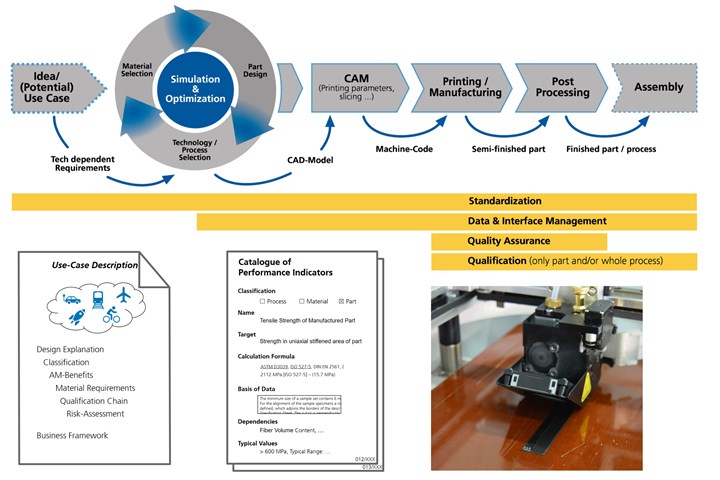EmpowerAX strengthens accessibility to continuous fiber 3D printing
Platform joins technology users and providers to work on standards, tests and frameworks for faster, lower-cost evaluation and implementation of additive extrusion technologies for industrial parts.

DLR EmpowerAX is working on a catalog of performance indicators, standard test methods (lower right) and frameworks for evaluating additive extrusion (AX) technologies to help speed implementation for industrial parts production. Photo Credit: DLR, EmpowerAX
EmpowerAX is an international and industry-diversified technology platform encompassing the technology competence along the entire process chain in collaboration with technology users and providers. The EmpowerAX team at the DLR Institute of Composite Structures and Adaptive Systems (Braunschweig, Germany) prepares work topics demanded by industry, which are then further elaborated with industrial partners and made available in a knowledge base. The goal is to accelerate the implementation of 3D printing technologies with continuous fiber-reinforced materials across a broader set of industries.
Which technology is most suitable for an industrial application and environment? What are the standards for evaluation? What is required to implement this technology? These are questions that EmpowerAX will help to answer, as explained in the Feb 2021 article, “DLR launches EmpowerAX to industrialize continuous fiber 3D printing.”
Companies and research institutes who join EmpowerAX as members participate in workshops that develop and advance the platform’s systems and knowledge base. EmpowerAX targeted progress for 2021 includes:

Additive manufacturing of continuous fiber-reinforced composite test specimens to determine defined performance indicators. Photo Credit: DLR EmpowerAX
Technology Assessment and Evaluation Chains: Completion of a First Stage Assessment Program and a Multi-Stage Evaluation Chain — both aimed to reduce the effort and investment required to identify and implement the most suitable AX technology for a given part. Possible technology users with a specific industrial application will conduct a first stage technology screening. This will identify potential candidates to evaluate using Technology Specification Sheets (TecSpecSheets) which include information on processable materials, the printing technology and process chain and the process integration for each AX technology. EmpowerAX is also working on standard test methods and a catalog of performance indicators (PI) for evaluating AX technologies.
Standardization and Qualification: Continue to identify standardization needs. Qualification requirements of four different industries have been defined and a framework for testing at various levels of printing complexity (e.g., coupon, subassembly, assembly) is being developed.
Quality Assurance: A catalog of defects and deviations is being established along with suitable nondestructive testing (NDT) methods for damage detection.
Simulation Methods: Existing simulation approaches are being evaluated and the information required for simulation is being defined.
Guidelines, Operation and Integration: Design guidelines are being established for AX continuous fiber parts and a framework for process assessment with regard to bottlenecks, individual capacity utilization, etc. using suitable reference productions is being developed.
Related Content
-
Automated robotic NDT enhances capabilities for composites
Kineco Kaman Composites India uses a bespoke Fill Accubot ultrasonic testing system to boost inspection efficiency and productivity.
-
ASCEND program update: Designing next-gen, high-rate auto and aerospace composites
GKN Aerospace, McLaren Automotive and U.K.-based partners share goals and progress aiming at high-rate, Industry 4.0-enabled, sustainable materials and processes.
-
Plant tour: BeSpline/Addcomp, Sherbrooke, QC, Canada
Composites automation specialist increases access to next-gen technologies, including novel AFP systems and unique 3D parts using adaptive molds.















